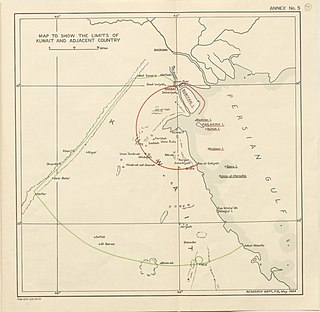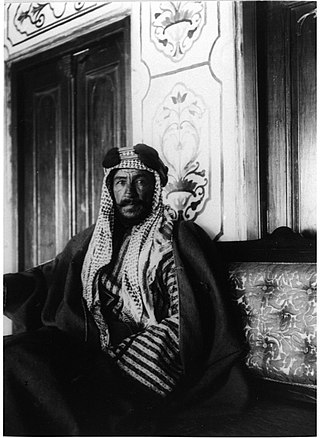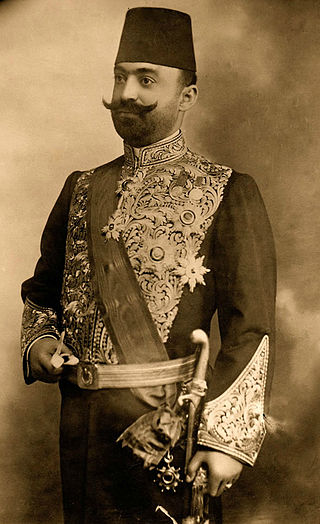Related Research Articles
Kuwait is a sovereign state in Western Asia located at the head of the Persian Gulf. The geographical region of Kuwait has been occupied by humans since antiquity, particularly due to its strategic location at the head of the Persian Gulf. In the pre-oil era, Kuwait was a regional trade port. In the modern era, Kuwait is best known for the Gulf War (1990–1991).

The history of Qatar spans from its first duration of human occupation to its formation as a modern state. Human occupation of Qatar dates back to 50,000 years ago, and Stone Age encampments and tools have been unearthed in the Arabian Peninsula. Mesopotamia was the first civilization to have a presence in the area during the Neolithic period, evidenced by the discovery of potsherds originating from the Ubaid period near coastal encampments.

The House of Sabah is the ruling family of Kuwait.

The Anglo-Ottoman Convention of 1913, also known as the "Blue Line", was an agreement between the Sublime Porte of the Ottoman Empire and the Government of the United Kingdom which defined the limits of Ottoman jurisdiction in the area of the Persian Gulf with respect to Kuwait, Qatar, Bahrain, and the Shatt al-Arab. It was signed on 29 July 1913, but never ratified. The long-lasting impact of the agreement was that of the status of Kuwait; the basis for both formal independence and the frontiers of modern Kuwait were established.
Sheikh Abu Salman Sabah I bin Jaber Al Sabah was the first ruler of the Sheikhdom of Kuwait. He was chosen by his community for the position of sheikh.

Sheikh Mubarak Al-Sabah "the Great", nicknamed "The lion of the peninsula", was the seventh ruler of the Sheikhdom of Kuwait, from 18 May 1896 until his death on 18 November 1915. Mubarak ascended the throne upon killing his half-brother, Muhammad Al-Sabah. Known for his significant role in shaping modern Kuwait, the constitution of the State of Kuwait mandates that the Emir of Kuwait must be a descendant of Mubarak from the ruling Al-Sabah family.
Sheikh Abdullah II Sabah II Al-Jabir I Al-Sabah was a cavalry commander in the Military of Kuwait and was the fifth ruler of the Sheikhdom of Kuwait from 1866 to 1892. The eldest son of the fourth ruler of Kuwait, Sabah II, his reign was marked by efforts to manage natural disasters, maintain stability, and fortify ties with the Ottoman Empire, a key supplier of drinking water for Kuwait. Notably, the first coins minted in Kuwait were during his tenure.

The Basra Vilayet was a first-level administrative division (vilayet) of the Ottoman Empire. It historically covered an area stretching from Nasiriyah and Amarah in the north to Kuwait in the south. To the south and the west, there was theoretically no border at all, yet no areas beyond Qatar in the south and the Najd Sanjak in the west were later on included in the administrative system.

Muhammad bin Sabah Al-Sabah also known as Noor Al Sabah, was the sixth ruler of the Sheikhdom of Kuwait between May 1892 and May 1896 during which he held the title of Pasha from the Ottoman Sultan. He was the second son of Sabah II Al-Sabah and succeeded his half-brother Abdullah II Al-Sabah upon his death in 1892.

The Persian Gulf Residency was a subdivision of the British Empire from 1822 until 1971, whereby the United Kingdom maintained varying degrees of political and economic control over several states in the Persian Gulf, including what is today known as the United Arab Emirates and at various times southern portions of Iran, Bahrain, Kuwait, Oman, and Qatar.

Khawr al Udayd, is a settlement and inlet of the Persian Gulf located in Al Wakrah Municipality in southeast Qatar, on the border with Saudi Arabia. It is known to local English speakers as the "Inland Sea". In the past it used to accommodate a small town and served as the center of a long-running territorial dispute between Sheikh Jassim bin Mohammed Al Thani and Sheikh Zayed bin Khalifa Al Nahyan. At the present, it is a major tourist destination for Qatar.

Abdullah bin Jassim bin Mohammed Al Thani, also known as Sheikh Abdullah bin Jassim Al Thani or Sheikh Abdullah bin Qassim Al Thani, was the Emir of Qatar. He was born in 1880 in Doha, the capital city of Qatar. He then abdicated in favour of his crown prince and second son, Sheikh Hamad bin Abdullah Al Thani, in 1940. Sheikh Hamad died eight years later and Sheikh Abdullah assumed office once again until 1949, when he stepped down from office in favour for his eldest son, Sheikh Ali bin Abdullah Al Thani. Oil was also discovered for the first time during his rule.

The Trucial States, also known as the Trucial Coast, the Trucial Sheikhdoms, Trucial Arabia or Trucial Oman, was a group of tribal confederations to the south of the Persian Gulf whose leaders had signed protective treaties, or truces, with the United Kingdom between 1820 and 1892.
Sheikh Jaber bin Abdullah was the third ruler of the Sheikdom of Kuwait. He governed from 1814 to 1859. He was the eldest son of Abdullah bin Sabah whom he succeeded upon Sheikh Abdullah's death.

The Sheikhdom of Kuwait was a sheikhdom during the pre-oil era. The sheikhdom became a British protectorate between 1899 and 1961 following the Anglo-Kuwaiti agreement of 1899. This agreement was made between Sheikh Mubarak Al-Sabah and the British Government in India, primarily as a defensive measure against threats from the Ottoman Empire. After 1961, the sheikdom became the state of Kuwait.

The sanjak of Najd was a sanjak of the Ottoman Empire. The name is considered misleading, as it covered the al-Hasa region, rather than the much larger Najd region. It was part of Baghdad Vilayet from June 1871 to 1875, when it became part of the Basra Vilayet.

Talib Pasha bin Rajab Al-Naqib Al-Refa'i was an Iraqi politician, who became the first Minister of Interior in Iraq.

The Al-Hasa Expedition was an Ottoman military campaign to annex the El-Hasa region of eastern Arabia. Ostensibly launched to assist Imam Abdullah bin Faisal in reclaiming control over Najd from his brother Saud bin Faisal, the underlying motive was Medhat Pasha's ambition to extend Ottoman dominion over the Persian Gulf.
Abdulaziz Abdul Ghani Ibrahim was a Sudanese researcher and university professor. He has a number of publications related to the history of the Arabian Gulf region, old civilizations, and the Arabian Peninsula, and one of his books is Britain and The Emirates of The Omani Coast, published in 1978.

The campaign of Ali Al-Kahiya or the campaign of Ali Al-Kikhia was a campaign that took place in the year 1213 AH/1798 AD and was led by Ali Pasha Al-Kakhiya or Al-Kahiya to invade Al-Ahsa in the year 1798 AD in preparation for the march towards Diriyah. This campaign came out in the wake of the collapse of the Thuwaini bin Abdullah Al-Saadoun campaign to stop the Wahhabi attacks against the cities. And in the valley of southern Ottoman Iraq, especially the pastures of Emirate of Muntafiq, after the assassination of Sheikh Thuwaini. In the year 1798 AD, Minister Sulayman Pasha the Great prepared a large campaign of men and weapons and supplemented it with units from the Shammar tribes led by Sheikh Faris bin Muhammad al-Jarba and Ali al-Kahiya. However, the campaign failed in its mission after a peace was established between the two parties.
References
- 1 2 3 "Kuwait: Anglo-Ottoman Relations 1890-1914" (PDF). Shodhganga Thesis Repository. 1994. Retrieved 16 November 2017.
- ↑ "'File 53/6 (D 2) Koweit [Kuwait] Affairs, 1898-1899'". Qatar Digital Library. Retrieved 16 November 2017.